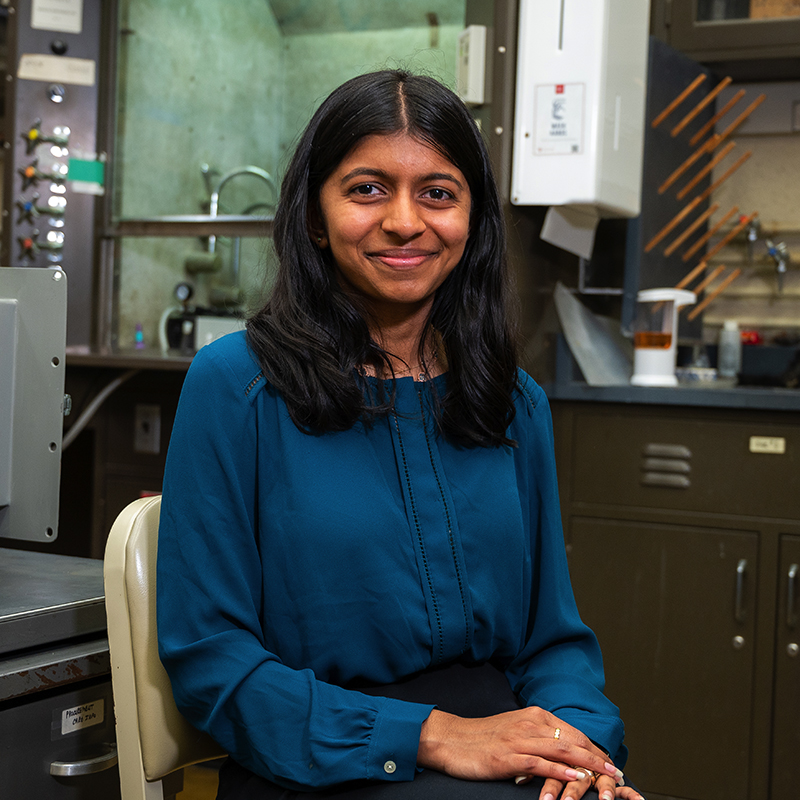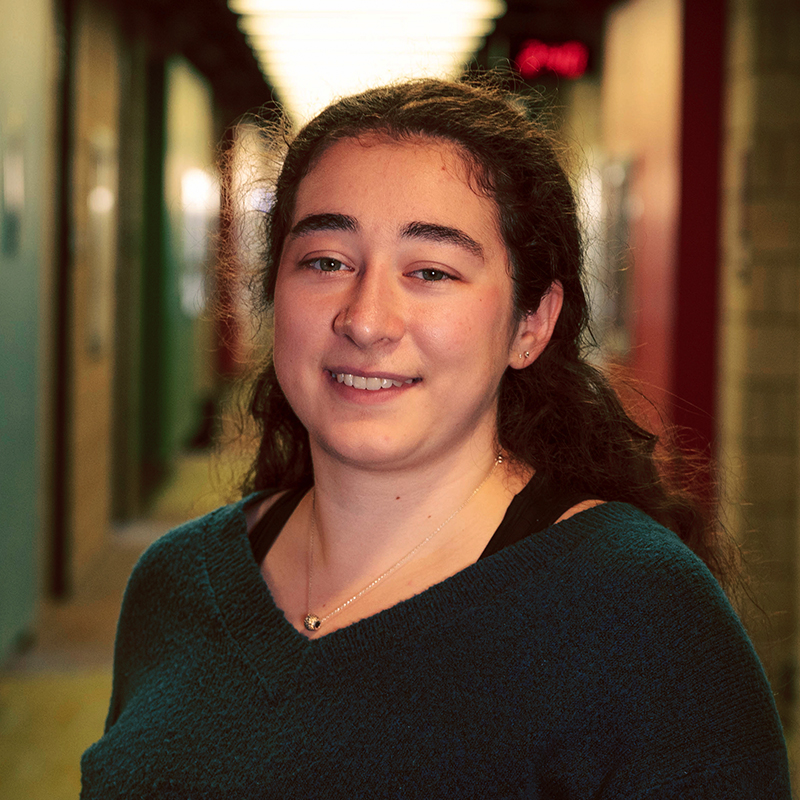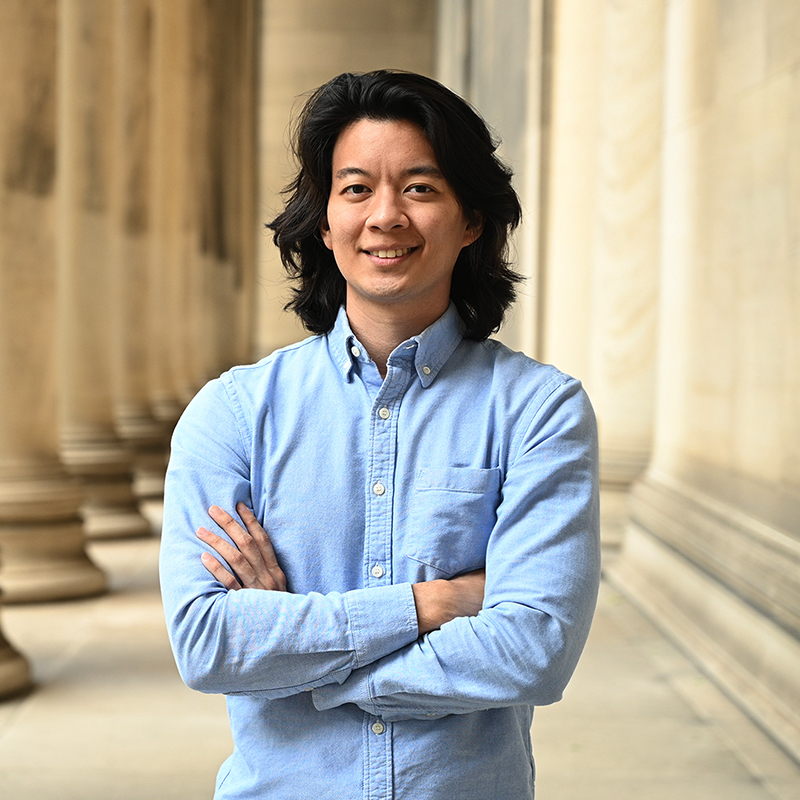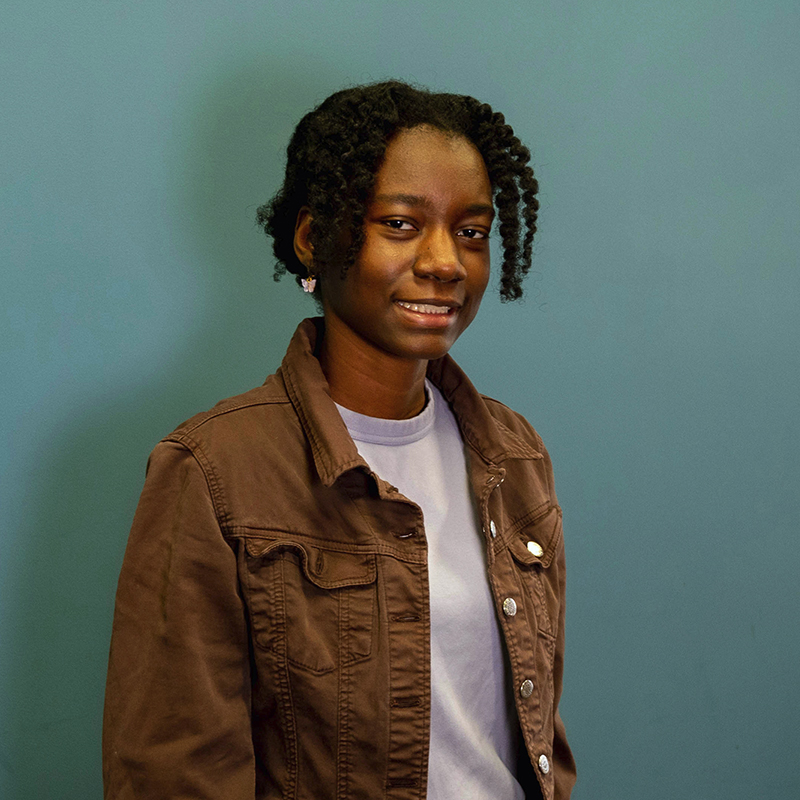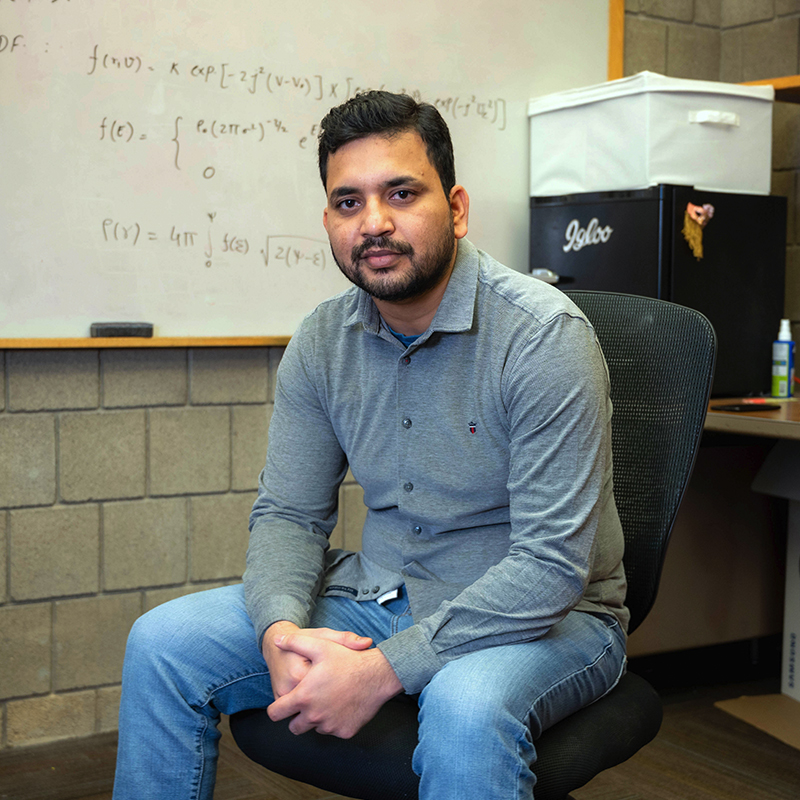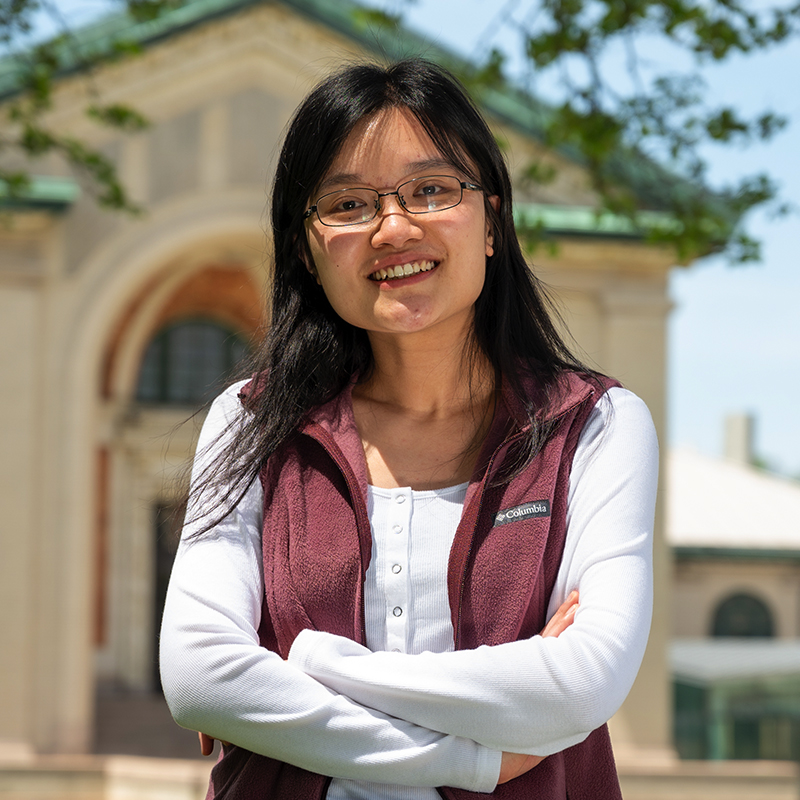
Sindhu Murthy
Outreach Position Sparks Interest in Physics Among K-12 Students
Byron Daniel wondered why students did not enter physics.
“Thinking back to when I was a child, I remember that physics was usually presented as a subject too complex or impossible to master,” said Daniel, a doctoral candidate in Carnegie Mellon University’s Department of Physics. “Physics is a difficult subject, yes, but like riding a bicycle one can both learn and master physics with proper guidance and practice.”
As the first person to hold the physics diversity and outreach teaching assistant position, Daniel would visit schools and offer teachers resources to better tackle the subject.
The position was initially suggested by Carl Rodriguez, assistant professor of physics. Graduate students in the TA position spend 15 hours a week reaching out into the community and promoting diverse voices in physics. The pilot program, approved by Rebecca Doerge, the Glen de Vries Dean of the Mellon College of Science, and Scott Dodelson, professor and department head of physics, is now in its third year.
“Historically, physics has not been a very welcoming place for women or for most minorities,” Dodelson said. “We understand some of the reasons, and we’re trying to address them, but we really have to turn to the input we get from younger people with different perspectives.”
Daniel saw the position as a way to introduce young people to physics in a more accessible way. He used the role to create opportunities for underrepresented elementary, middle and high school students to learn more about physics and consider future careers.
“I felt failure on my part would mean that the students of Pittsburgh would be deprived of opportunities that they so desperately need,” Daniel said. “So, I spent the year working very hard to establish connections between Pittsburgh Public Schools and the Physics Department.”
Though the pandemic hindered some options, such as in-person demonstrations, Daniel laid a strong foundation for his successor and fellow graduate student, Sindhu Murthy (right), to expand.
Murthy knew Daniel from classes, and they shared concerns about how few students from underrepresented backgrounds were in physics. She used many of the connections Daniel had formed and created more in-person programs for students. She and other physics students went into Pittsburgh Public Schools and demonstrated multiple physics experiments.
“We spent an entire day with the students doing demos, taking their questions and keeping them engaged,” Murthy said. “I heard afterward a lot of students were very happy to see me. I think it was because they identified with someone like me, and I was demonstrating exciting instruments and explaining the physics. That had an impact on the students, and I am really proud of being that face.”
Besides offering resources to schools, Murthy provides physics students a sounding board. She listens to their thoughts on issues related to diversity and outreach then shares some of the themes with the department.
“It’s a really good thing that the Physics Department is trying to get fresh voices in there, because if there’s too much of the old way of doing things, it’ll potentially steer bright young people away,” Murthy said.
Murthy’s teaching assistant term ended in August, and Carleen Markey is in the position this fall, and Kyungmin Park will take the reins in Spring 2023.
Murthy, Dodelson and Daniel said they hope the positions expands in the future.
“The college and university are really committed to making changes,” Dodelson said. “This is one of the best ways I’ve seen of really making changes. People are really working hard to make things happen.”
Daniel said he would love to see similar positions emerge across the university. “I hope that more departments at CMU adopt this position,” Daniel said.
“Over the past two years, I have had the chance to see the positive impact that Sindhu and I had on physics education in Pittsburgh. I would love for other CMU STEM departments to have similar positive impacts.”
■ Kirsten Heuring
Tanvi Jakkampudi
Tanvi Jakkampudi Awarded Fulbright Scholarship
Tanvi Jakkampudi, who graduated in 2022 with a bachelor’s degree in physics (biological physics track) and a minor in biomedical engineering, earned a research award to study antimicrobial peptides, known as AMPs, at the Deutsches Elektronen-Synchrotron (DESY) in Hamburg, Germany. DESY is home to one of the largest centers for particle accelerators.
“At DESY I will have the opportunity to utilize the world’s leading high-energy synchrotron to characterize the peptides’ structure and analyze interactions between the peptides and lipid model membranes to reveal possible bacterial-killing mechanisms,” Jakkampudi said.
She said that Germany was interesting for her because of its drive to lead international innovation in physics as well as Germany’s dedication to the health and well-being of its residents.
“I want to volunteer at a Hamburg clinic and explore how the German government sustainably runs their national health care program, so I can implement these practices through my nonprofit, Health Hub, to expand free access to health care to underserved communities across America,” she said.
At CMU, Jakkampudi conducted research with Stephanie Tristram-Nagle, a research professor emerita of biophysics, and Peter Di, an associate professor of environmental and occupational health at the University of Pittsburgh. She said the collaboration shaped her college experience and has sparked an interest and appreciation for combining physics and medicine.
“I have had incredible opportunities to explore this intersectional interest during my college years, and while my intended goal is to attend medical school and become a physician-scientist, I want to take one year between graduating from Carnegie Mellon and matriculating to medical school to further strengthen my research experience,” she said.
■ Heidi Opdyke
Emma Clarke
Emma Clarke Awarded Pake Fellowship
With advisers on two continents, scheduling meetings can be a challenge for Emma Clarke.
This fall, the Ph.D. student in Carnegie Mellon University’s Department of Physics spent several months in Sweden working at the Nordic Institute for Theoretical Physics (Nordita), part of the University of Stockholm, which made meeting with one of her advisors, Axel Brandenburg, much easier.
“One perk was no longer having the time difference and having the same overlapping working hours for meetings. It’s good for learning more about the simulations and modifying that code with collaborators. It’s just a bit easier to look at each other’s screens and have that live interaction,” said Clarke who is studying astrophysics and cosmology under the guidance of Brandenburg and Associate Research Professor Tina Kahniashvili. They have worked together for three years.
“Emma is a deep thinking student. She’s very creative in her research,” Kahniashvili said. “The subject that she’s working on is very multidisciplinary and requires novel perspectives of physics, astronomy and numerical simulations. I’m happy for her to have this opportunity.”
Clarke is studying gravitational waves from the very early universe to predict their background source signatures. While in Sweden she worked on magnetic hydrodynamic simulations with the use of supercomputers and Pencil Code, which was developed by Brandenburg, to solve partial differential equations on massively parallel machines.
The extended stay was courtesy of Clarke’s recent award of the George E. and Marjorie S. Pake Fellowship in Physics.
The fellowship, which supports a Department of Physics graduate student, is named after George E. Pake, a physicist who studied nuclear magnetic resonance and received his bachelor’s and master’s degrees from the Carnegie Institute of Technology, and his wife Marjorie. After spending time as a professor and provost at Washington University of St. Louis, where he conducted research that contributed to the rise of magnetic resonance imaging, Pake served as the founding director of Xerox Palo Alto Research Center, a subsidiary of Xerox Corporation that supported pioneering research into computing.
Clarke said she came to Carnegie Mellon because of the depth and breadth of the cosmology group, which includes research in computational, observational and theoretical areas.
“I wasn’t exactly sure what route to take within cosmology and that gave me some options to explore,” she said. “And CMU has a physics research rotation program where it’s encouraged to try different groups before picking your thesis advisor.”
Brandenburg is an adjunct faculty member at Carnegie Mellon as well as a Professor of Astrophysics at Nordita and the University of Stockholm.
When in Pittsburgh, Clarke serves as a graduate teaching assistant for courses such as Matter and Interactions and Mathematical Methods of Physics as well as teaching Introduction to Astronomy. She also competes with the CMU Figure Skating Club intercollegiate team.
■ Heidi Opdyke
Michael Andrews
Physics Graduate’s Pioneering Work Recognized by CERN Experiment
What started as a side project by Carnegie Mellon University’s Michael Andrews has turned into a pioneering use for machine learning in physics. Andrews, who recently earned his Ph.D. in physics, said members of the Compact Muon Solenoid (CMS) experiment that operates at the Large Hadron Collider at CERN in Switzerland, would use processed data and neural networks to advance research in particle physics.
“Michael is an incredibly good physicist,” said Manfred Paulini, professor of physics and Andrews’ adviser and a CMS researcher. “Machine learning is a tool, and with every tool, you have to check and calibrate it. Michael knows how to use these tools and appreciate them.”
Paulini and other researchers who are part of the CMS experiment previously used processed data and neural networks to advance their research in particle physics. However, a couple of years into his doctoral studies, Andrews said he realized how powerful machine learning could be. He started exploring how it could be applied to his and Paulini’s research.
“I was keen to reassure Manfred that this was just a side project, and it would not distract from my original thesis,” Andrews said. “Things matured and showed promise, and at a certain point, we both agreed that it would be more fruitful if we switched thesis topics to something that really sold the strategy on using machine learning on raw sensor data.”
Since no one had used raw data and machine learning in this area of particle physics before, Andrews created many of the processes from scratch. He looked into details of disentangling two photons that overlap in the detector and were previously reconstructed as a single photon with conventional analysis techniques. This process was extremely laborious, and he had to extend his Ph.D. studies. However, thanks to his hard work, CMS now has a new way to analyze data and gain more understanding of high-energy collisions.
For his efforts, the CMS collaboration recognized him with the CMS Thesis Award. The award honors three graduating doctoral students who work on the CMS experiment.
“CMS is a very big collaboration. It’s very hard to do anything new,” Andrews said. “The mindset has changed from when I started to where it is now. When I first started with this, there was a lot of pushback with this idea, but today, that’s changed. We were the first to demonstrate how using raw sensor data could not just work but really make a big difference.”
Andrews wrapped up both his Ph.D. and his postdoctoral studies with Paulini. He now works at Theorem, a startup created by CMU alumnus Hugh Edmundson, where he applies his knowledge of machine learning to new problems in finance. However, he has left a lasting impact on physics research.
“Before Michael, I had ignored machine learning for a very long time,” Paulini said. “He was really the driving force of getting into what we can do with respect to machine learning. This is the beauty of being a professor, you can learn together with your students.”
■ Kirsten Heuring
Ann-Marsha Alexis
Ph.D. Candidate Pivots from Modeling Earth to Galactic Ideas
Ann-Marsha Alexis, a first-year Ph.D. student in physics at Carnegie Mellon University, has been awarded the John Peoples Jr. Fellowship in Physics. The fellowship provides a stipend and allows first-year graduate students to explore research in their first semester.
“I really like the department. It’s very supportive, and a lot of the research is interesting to me,” said Alexis, who graduated from Wellesley College with a bachelor’s degree in computer science.
She uses computational techniques to study the sciences, particularly physics. For example, she created computational models to predict effects of climate change. Using the physics of fluid dynamics, she built tools to determine the effects of climate change in Mozambique, which is prone to flooding.
“I was always interested in using the physics of climate change, and modeling and simulations in general,” Alexis said. “It wasn’t new physics research, but it was using physics, which interested me.”
Alexis is now applying her modeling skills to computational astrophysics. Her advisor, Rupert Croft, a professor of physics, said that her computer science background helps her stand out from other doctoral candidates.
“Although we don’t study climate change in the Physics Department directly, we’ve recently had a lot of people working on climate change coming through because of the NSF Artificial Intelligence Institute hosted in the Physics Department,” Croft said. “They’re studying our planet. We study galaxies and other things. But we use similar computational techniques.”
Currently, Alexis is simulating spectra to determine the formation of galaxies, in collaboration with researchers from other institutions working with the James Webb Telescope to further develop large-scale cosmological models.
Alexis and Croft are using data gathered from the telescope to enhance their cosmological simulations and, in turn, suggesting areas of space to investigate.
“Right now, we are making predictions for what the galaxy should look like,” Croft said. “Our computer simulation — the one that Ann-Marsha is working on — we’re using that to make galaxy images that we’re comparing to the real data.”
Outside of the lab, Alexis enjoys hiking and music. She learned traditional drumming, and she is learning to play the organ. However, physics is her major passion.
“I’m looking forward to see where the Ph.D. takes me,” Alexis said.
■ Kirsten Heuring
Kuldeep Sharma
Cosmologist Awarded J. Michael McQuade Fellowship in Physics
As an aerospace engineer at the Indian Space Research Organization, Kuldeep Sharma modeled launch vehicles for structural dynamics analysis.
Now a doctoral student at Carnegie Mellon University, Sharma has pivoted to studying the universe itself rather than the methods to get humans into space.
“My interest in astronomy started shifting during undergraduate (at the Indian Institute of Space Science and Technology),” said Sharma, who earned his master’s degree in astronomy at Leiden University prior to joining Carnegie Mellon’s Department of Physics. “It felt like addressing an existential question of humankind that we have been thinking about for many centuries.”
Sharma works with Carl Rodriguez, an assistant professor of physics and a member of the McWilliams Center for Cosmology. His work focuses on gravitational waves, ripples in spacetime that were first observed by the Laser Interferometer Gravitational-Wave Observatory (LIGO) in 2015. He is particularly interested in the dynamics and evolution of stars and star clusters, and what the gravitational waves they create can reveal about stars and galaxies across cosmic time.
“Kuldeep is an excellent researcher who uses computational techniques to study the collisions of massive stars and the massive black holes they create,” Rodriguez said. “His work will play a key role in our understanding of the formation of massive black holes and the gravitational waves they produce.”
Next year, when Rodriguez joins the faculty of the University of North Carolina, Sharma will continue to work with him as a Carnegie Mellon student using Cluster Monte Carlo code and LIGO evidence.
“I’m looking at one aspect of the collisions of individual stars in certain regions where the densities of stars are very high, which leads to the formation of massive stars and then the formation of massive black holes,” Sharma said, who previously worked under the supervision of then-Carnegie Mellon Assistant Professor Sergey Koposov on mass estimation of the Large Magellanic Cloud using the proper motion data of Blue Horizontal Branch stars from Gaia.
For his research efforts, Sharma received the J. Michael McQuade Fellowship in Physics.
“I’m very grateful and thankful that I’m here at Carnegie Mellon,” Sharma said. “The university has been very generous during my studies, and this fellowship will let me focus on research.”
■ Heidi Opdyke
Yueying Ni
Physics’ Yueying Ni Receives Berry Research Award
Yueying Ni, a Ph.D. candidate in the Department of Physics, has received the Guy C. Berry Graduate Research Award for her accomplishments while developing cosmological simulations to study supermassive black holes.
“I’m very grateful that I have had the opportunity to check out this exciting frontier in research with my advisor, Tiziana Di Matteo,” said Ni.
Supermassive black holes are extremely rare in the early universe, with one in a billion chances of occurring in a galaxy. By investigating the formation mechanism of those uncommon objects, Ni hopes that she can gain better understanding of what extreme initial conditions of the universe can bring about those first supermassive black holes.
“Supermassive black holes are one of the most mysterious, intriguing objects in the early universe,” said Ni. “They are also very important regulators for galaxy formation, and it’s crucial to understand how they co-evolve with their host galaxies.”
Ni has developed one of the largest cosmological simulations in her field, focusing on studying the growth and assembly history of the supermassive black holes and their coevolution with galaxies over the cosmic history.
Based on her research, Ni has found some of the conditions that are necessary to form supermassive black holes in the very early universe.
“You need a very extreme environment with a very extreme high initial density peak that’s able to grow and form large structures very early, and you need a very compact internal environment to be able to form a very dense gas environment,” said Ni. “You need to have enough material to feed those early conditions and allow them to grow to a very large mass.”
Ni also developed AI-assisted cosmological simulations that use neural networks to model the small-scale physical process in large cosmological simulations. It can greatly reduce the expense of simulations, and it provides a potential solution for the next generation of cosmological simulations that need to cover an even larger dynamic range over many different scales of the universe.
Because of her advancements in astrophysics, Ni has been an author on 15 peer-reviewed publications and a first author on eight with more papers currently in progress. She also has been awarded multiple fellowships including the McWilliams Graduate Fellowship.
Ni works in the Matteo group run by Tiziana Di Matteo, director of the McWilliams Center for Cosmology and professor of physics. Matteo expressed pride in Ni’s innovations.
“It’s been such a pleasure to work with Yueying over the past five years. She’s developed into an outstanding, trailblazing scientist in her time at CMU,” said Di Matteo. “Yueying is driven and determined, she has the drive to persevere through all setbacks. Her research sits at the exciting interface between numerical astrophysics and the novel science questions that play a fundamental role within the fascinating discovery space of our field. I expect that her future work, as she moves to a prestigious fellowship at Harvard, will continue to have a major impact on the scientific community.”
■ Kirsten Heuring


